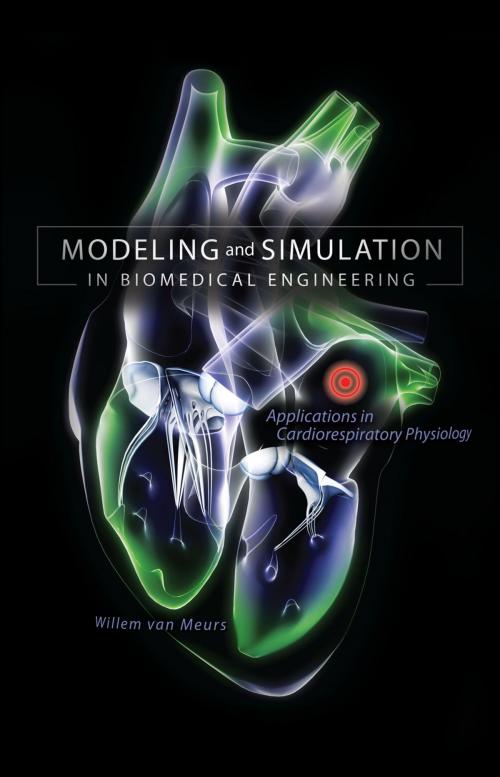Modeling and Simulation in Biomedical Engineering: Applications in Cardiorespiratory Physiology
Nonfiction, Science & Nature, Technology, Engineering, Chemical & Biochemical, Science, Biological Sciences, Biotechnology, Civil| Author: | Willem L. van Meurs | ISBN: | 9780071714464 |
| Publisher: | McGraw-Hill Education | Publication: | August 7, 2011 |
| Imprint: | McGraw-Hill Education | Language: | English |
| Author: | Willem L. van Meurs |
| ISBN: | 9780071714464 |
| Publisher: | McGraw-Hill Education |
| Publication: | August 7, 2011 |
| Imprint: | McGraw-Hill Education |
| Language: | English |
THEORY AND PRACTICE OF MODELING AND SIMULATING HUMAN PHYSIOLOGY
Written by a coinventor of the Human Patient Simulator (HPS) and past president of the Society in Europe for Simulation Applied to Medicine (SESAM), Modeling and Simulation in Biomedical Engineering: Applications in Cardiorespiratory Physiology is a compact and consistent introduction to this expanding field. The book divides the modeling and simulation process into five manageable steps--requirements, conceptual models, mathematical models, software implementation, and simulation results and validation.
A framework and a basic set of deterministic, continuous-time models for the cardiorespiratory system are provided. This timely resource also addresses advanced topics, including sensitivity analysis and setting model requirements as part of an encompassing simulation and simulator design. Practical examples provide you with the skills to evaluate and adapt existing physiologic models or create new ones for specific applications.
Coverage includes:
- Signals and systems
- Model requirements
- Conceptual models
- Mathematical models
- Software implementation
- Simulation results and model validation
- Cardiorespiratory system model
- Circulation
- Respiration
- Physiologic control
- Sensitivity analysis of a cardiovascular model
- Design of model-driven acute care training simulators
“Uniquely qualified to author such a text, van Meurs is one of the original developers of CAE Healthcare’s Human Patient Simulator (HPS). …His understanding of mathematics, human physiology, pharmacology, control systems, and systems engineering, combined with a conversational writing style, results in a readable text. …The ample illustrations and tables also break up the text and make reading the book easier on the eyes. …concise yet in conversational style, with real-life examples. This book is highly recommended for coursework in physiologic modeling and for all who are interested in simulator design and development. The book pulls all these topics together under one cover and is an important contribution to biomedical literature.” --IEEE Pulse, January 2014
“This book is written by a professional engineer who is unique in that he seems to have a natural understanding of 3 key areas as follows: the hardware involved with simulators, human physiology, and mathematical modeling. Willem van Meurs is one of the inventors of the model-driven human patient simulator (HPS), and so, he is very qualified to write this book. The book is written in a clear way, using the first person throughout, in a conversational manner, with a style that involves posing questions and answering them in subsequent text. …The book starts with a very useful introduction and background chapter, setting out the scene for the rest of the book. …I have used his book in enhancing my own talks and understanding human patient simulation and can strongly recommend it.” --Simulation in Healthcare December, 2012
Reviewed by Mark A. Tooley, Ph.D., Department of Medical Physics and Bioengineering, Royal United Hospital, Combe Park, Bath, UK.
THEORY AND PRACTICE OF MODELING AND SIMULATING HUMAN PHYSIOLOGY
Written by a coinventor of the Human Patient Simulator (HPS) and past president of the Society in Europe for Simulation Applied to Medicine (SESAM), Modeling and Simulation in Biomedical Engineering: Applications in Cardiorespiratory Physiology is a compact and consistent introduction to this expanding field. The book divides the modeling and simulation process into five manageable steps--requirements, conceptual models, mathematical models, software implementation, and simulation results and validation.
A framework and a basic set of deterministic, continuous-time models for the cardiorespiratory system are provided. This timely resource also addresses advanced topics, including sensitivity analysis and setting model requirements as part of an encompassing simulation and simulator design. Practical examples provide you with the skills to evaluate and adapt existing physiologic models or create new ones for specific applications.
Coverage includes:
- Signals and systems
- Model requirements
- Conceptual models
- Mathematical models
- Software implementation
- Simulation results and model validation
- Cardiorespiratory system model
- Circulation
- Respiration
- Physiologic control
- Sensitivity analysis of a cardiovascular model
- Design of model-driven acute care training simulators
“Uniquely qualified to author such a text, van Meurs is one of the original developers of CAE Healthcare’s Human Patient Simulator (HPS). …His understanding of mathematics, human physiology, pharmacology, control systems, and systems engineering, combined with a conversational writing style, results in a readable text. …The ample illustrations and tables also break up the text and make reading the book easier on the eyes. …concise yet in conversational style, with real-life examples. This book is highly recommended for coursework in physiologic modeling and for all who are interested in simulator design and development. The book pulls all these topics together under one cover and is an important contribution to biomedical literature.” --IEEE Pulse, January 2014
“This book is written by a professional engineer who is unique in that he seems to have a natural understanding of 3 key areas as follows: the hardware involved with simulators, human physiology, and mathematical modeling. Willem van Meurs is one of the inventors of the model-driven human patient simulator (HPS), and so, he is very qualified to write this book. The book is written in a clear way, using the first person throughout, in a conversational manner, with a style that involves posing questions and answering them in subsequent text. …The book starts with a very useful introduction and background chapter, setting out the scene for the rest of the book. …I have used his book in enhancing my own talks and understanding human patient simulation and can strongly recommend it.” --Simulation in Healthcare December, 2012
Reviewed by Mark A. Tooley, Ph.D., Department of Medical Physics and Bioengineering, Royal United Hospital, Combe Park, Bath, UK.















